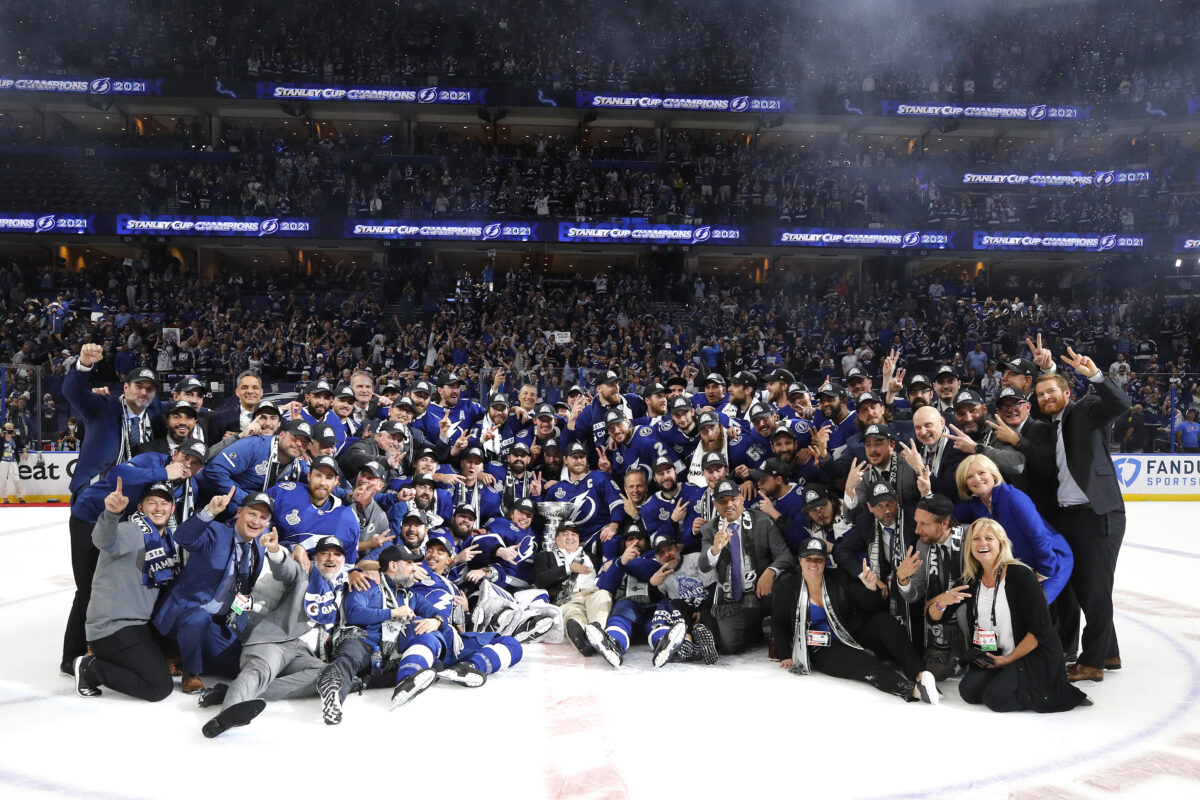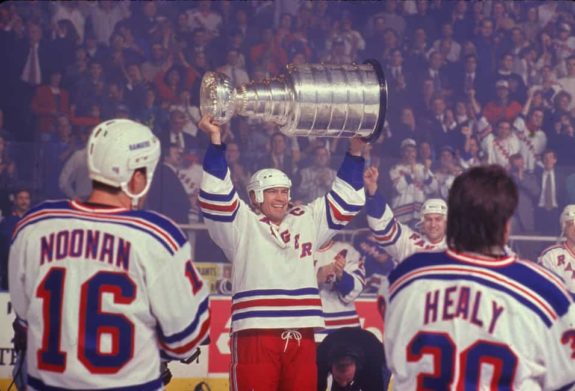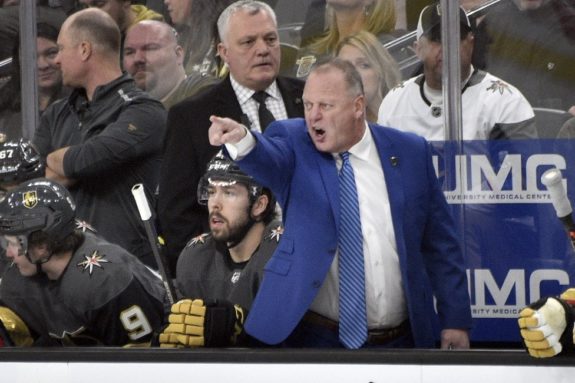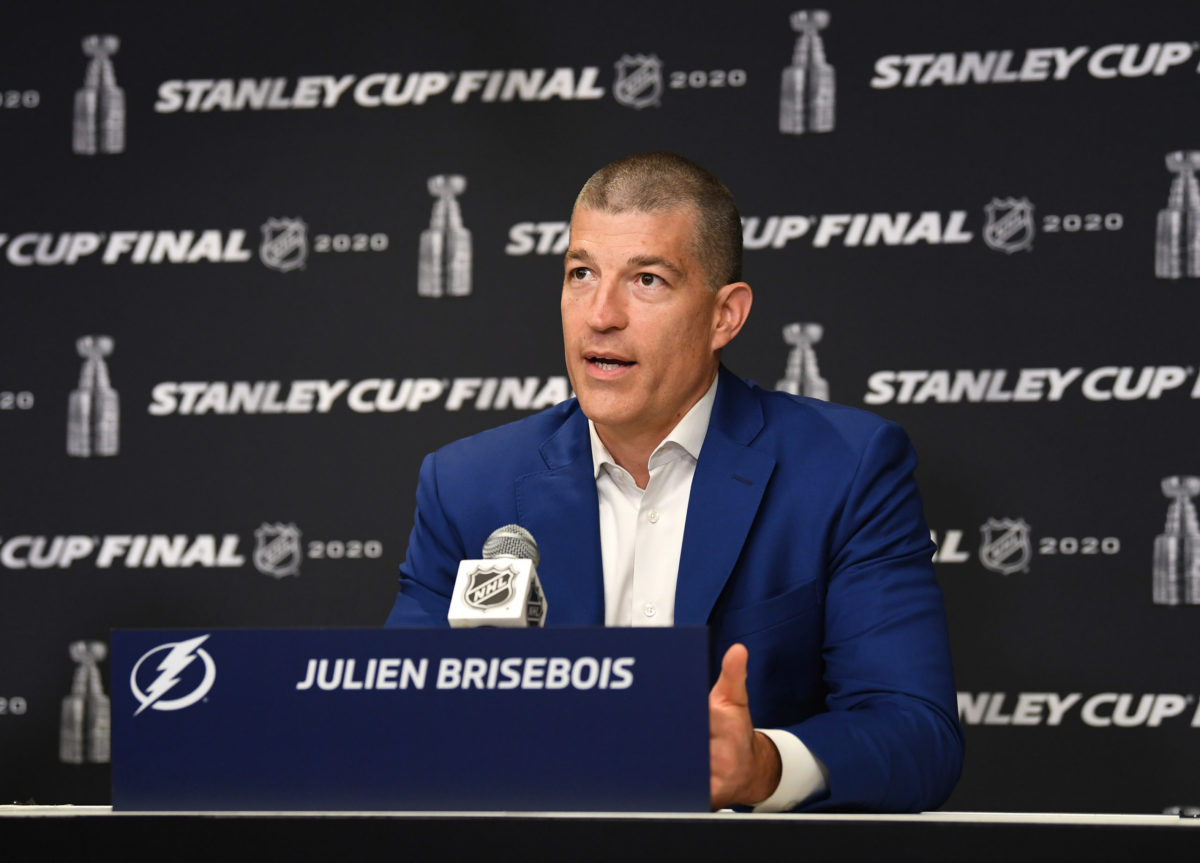Here are a couple of the New York Rangers’ major offseason needs:
- Established, top-six centerman who can score, win faceoffs and provide strong two-way play.
2. Veteran leadership for a talented but very young roster in need of direction.
New general manager Chris Drury could fill both needs with one player this summer, who might not be as expensive as a flashier option.
The Stanley Cup champion Tampa Bay Lightning will face a massive salary-cap crunch heading into next season, and their only option to become compliant is to move out more than one of their expensive contracts. The Lightning “got lucky” last season with an injury to star forward Nikita Kucherov that allowed them to dodge their cap problems for another season thanks to long-term injured reserve, but now is their time of reckoning.

Lightning general manager Julien BriseBois will have to consider every angle as he tries to pare tens of millions of dollars from the league’s biggest payroll, with both next season and 2021-22 in mind. That means identifying areas of strength and/or redundancy and finding bold solutions. One of those will likely be trying to trade center Steven Stamkos, their captain and a future Hall of Famer.
Losing him would be painful. Yet, it might be the least painful solution for Tampa Bay, which, even without Stamkos, is loaded down the middle with 20-somethings Brayden Point, Anthony Cirelli, and Yanni Gourde. They also managed to win their first of back-to-back Cups largely without Stamkos in 2020.
Stamkos Comes With Injury Risk, But He’s a Perfect Fit For Rangers
It’s a tough decision for BriseBois to make, but it’s worth considering. At 31 years old and with three seasons remaining at $8.5 million, Stamkos still has value on the trade market despite his high cap hit and recent health problems. The first-overall pick in the 2008 Draft played only 95 of 126 games over the last two seasons due to injuries, and only a short part of one game in the 2020 Playoffs, although he still managed to score a key goal, of course.
Stamkos’ effectiveness wasn’t at all compromised by injury, as he recorded 100 points over those 95 contests. He played in all 23 of the Lightning’s games in the 2021 postseason and recorded 18 points.

So, would he fulfill the Rangers’ needs? Faceoffs: A career-best 57.2 win percentage in 2020-21 and five straight seasons of at least 52.2 – check. Two-way play: A career Corsi for percentage of 57.0 – check.
Stamkos and Mika Zibanejad would give the Rangers the 1-2 punch at center they’ve craved for some time, and he would be a perfect fit on the roster. He is still in his prime and plays the type of game that’s aging well – provided, of course, that the injury bug doesn’t become a constant later in his career. His healthy postseason run in 2021 provides at least some encouraging evidence that the past two seasons will prove to be outliers – though he has dealt with some injury issues in his 13 NHL seasons.
However, Stamkos’ timing would be perfect for the team, in the dressing room, and on the bench. Though the parallel is hardly perfect, another star centerman came to Broadway via trade at about the same age as Stamkos and transformed the franchise: Mark Messier.
Messier was 30 years old when the Edmonton Oilers, needing to cut costs similar to Tampa Bay, dealt him to the Rangers on Oct. 4, 1991. A proven winner with five Stanley Cups with the Oilers, Messier joined a talented but young team desperate for guidance.

Sound anything like today’s Blueshirts?
We all know the rest. Messier’s drive and determination brought direction to the team and boosted their young stars. The Rangers became a championship contender in 1991-92 and ended their 54-year Cup drought two seasons later, with Messier leading the way with countless unforgettable moments that live in franchise lore.
A Stamkos-Gallant Pairing Could Rival Messier-Keenan Partnership
Along with his play and leadership, Messier, in his third season, helped establish their head coach. His bond with newly-hired Mike Keenan before the 1993-94 season eased Keenan’s arrival and validated his often-irritating methods as a necessary evil for the Blueshirts to chase the Cup.
The Rangers will welcome a new coach in 2021-22 after Gerard Gallant was hired to replace David Quinn. Perhaps Stamkos could be the on-ice partner the intense, demanding Gallant needs to get his message across.
Again, it isn’t a perfect comparison. Messier, who saw the writing on the wall as Edmonton’s dynasty was dismantled and had nothing left to prove as an Oiler, demanded a trade and welcomed the challenge that would face him in New York. Stamkos’ feelings about being traded from the only team he’s played for are unknown, and he has a no-movement clause that will allow him to control this process. While it was clear that the Oilers of the early ’90s were headed for a major downturn, the Lightning’s loaded roster will make them contenders for years to come. Asking the team captain who just helped Tampa Bay win its second straight championship won’t be easy.

Still, it would behoove the Rangers to see if Stamkos is up for a similar undertaking that Messier embraced and for which he was richly rewarded.
Though some of the Rangers’ young assets would need to head south to bring Stamkos to the Big Apple, he would be joining a team that includes (some combination of) the 2020 first-overall draft pick Alexis Lafrenière, the 2019 second-overall pick Kaapo Kakko, the ninth-overall pick in 2018 Vitali Kravtsov, the 2021 Norris Trophy winner Adam Fox, and goaltender Igor Shesterkin. There’s also Zibanejad and Artemi Panarin, meaning Stamkos would be joining a club that also boasts established star power.
Stamkos and Messier don’t have the same leadership style. Messier’s fire and intimidating presence allowed him to impose his will on his team and even on the front office when necessary – he made it clear that coach Roger Neilson was not the man to lead the Rangers after a disastrous 1992-93 season. Stamkos’ approach is different but plenty effective. His strong presence and professionalism set the tone for a Lightning team that’s been in the business of doing whatever it takes to win consecutive championships the past two seasons.
That tone is what the Rangers’ youth needs. Brian Leetch, Alexei Kovalev, Sergei Zubov, Tony Amonte, and others saw their games improve, some of them dramatically, once Messier arrived. Adding Stamkos could have the same effect on the Rangers’ current crop of youngsters who need help finding their way in the NHL.
There are other advantages to bringing Stamkos to New York. The Rangers have been closely tied to Jack Eichel for the last two offseasons, and the disgruntled Buffalo Sabres center appears to be on his way out. Yet, the Sabres have demanded a huge package for the 24-year-old, despite a neck injury that ended his season after 21 games in 2020-21 and a contract that runs for five more seasons at $10 million per. Despite his talent, Eichel is a gamble, and the prohibitive cost (in trade capital and salary) to acquire him is heightened by the fact that Sabres have multiple suitors.
Rangers Seeking More Veteran Presence in Lineup, Not More Youth
Stamkos’ contract, while also a big one to swallow, expires after the 2023-24 season, two years before Eichel’s. It wouldn’t haunt the Rangers’ cap situation deep into the future and should make re-signing Zibanejad to a big extension more feasible. There’s also a limited number of teams that can absorb the contracts that Tampa Bay wants to trade – especially with a flat cap next season. However, with upwards of $20 million in cap space for 2021-22, the Rangers are among them.
Though Eichel is seven years Stamkos’ junior, ownership and management have made it clear that they don’t consider the overwhelmingly young roster an asset. Dismissing the former regime – president John Davidson and Jeff Gorton – by owner James Dolan was done, in part, because Dolan felt the club was moving too slowly; that contention was too far away after three-plus seasons of rebuilding. That new management is expected to try to add a veteran defenseman who can play significant minutes this offseason seems to be in line with that thinking.
We know the club has a leadership void. There are not enough experienced, respected voices who can direct a bunch of talented kids who need just that. The Messier acquisition was criticized by some at the time for bringing in an aging player who didn’t have much left. Instead, Messier proved to be the missing ingredient, the veteran presence who generated urgency and imposed a championship goal around which the entire organization rallied. Could Stamkos do that too?

All of this is academic if the Lightning set an unrealistically high price for Stamkos. He should cost less than Eichel. He is older, and the Rangers should have more leverage in this situation than they do with the Sabres. BriseBois is over a barrel as he tries to start slashing his payroll. Kucherov and goaltender Andrei Vasilevskiy, the Lightning’s largest cap hits at $9.5 million apiece, aren’t going anywhere. Veteran forward Tyler Johnson, whose onerous contract runs three more seasons at $5 million per, will be next to impossible to trade. The club could leave former Ranger Ryan McDonagh exposed in the upcoming expansion draft, but even if the Seattle Kraken take his annual $6.75 million cap hit off their books, the Lightning will need to clear more salary.
Dealing Stamkos would allow Tampa Bay to trade from a position of strength, moving out a player that’s still effective and desirable and who would provide significant cap relief. The Lightning’s roster doesn’t have many other similar opportunities.
Lightning’s Long-Term Salary-Cap Mess Should Make Stamkos Affordable
Point, the club’s 25-year-old top center, will be a restricted free agent with arbitration rights after next season and must be signed to a big extension. Rising 23-year-old defenseman Mikhail Sergachev is due for a significant raise from his $4.8 million hit after 2022-23. The same can be said of bruising 24-year-old defender Erik Cernak, who has a plus-44 rating in his three seasons with the club and will become an RFA at the same time as Sergachev. BriseBois is facing a daunting balancing act to keep his team among the NHL’s elite while significantly reworking its salary structure.
Stamkos will cost the Rangers, but they shouldn’t give up too much, certainly not as much as the Sabres are demanding for Eichel. Yet, they should try to figure out a deal for the player with 866 points in 841 career games. The Lightning and Rangers might be ideal trading partners this offseason: desperate to clear salary, Tampa Bay can remain strong and deep at center while picking up inexpensive young talent from the Blueshirts’ highly-regarded pool of prospects and young players.

For the Rangers, Stamkos might be the right player at the right time, just as Messier was. A player who would signal an end to the rebuild and begin to lead the Blueshirts down the arduous path toward a Stanley Cup – just as he did with the Lightning.